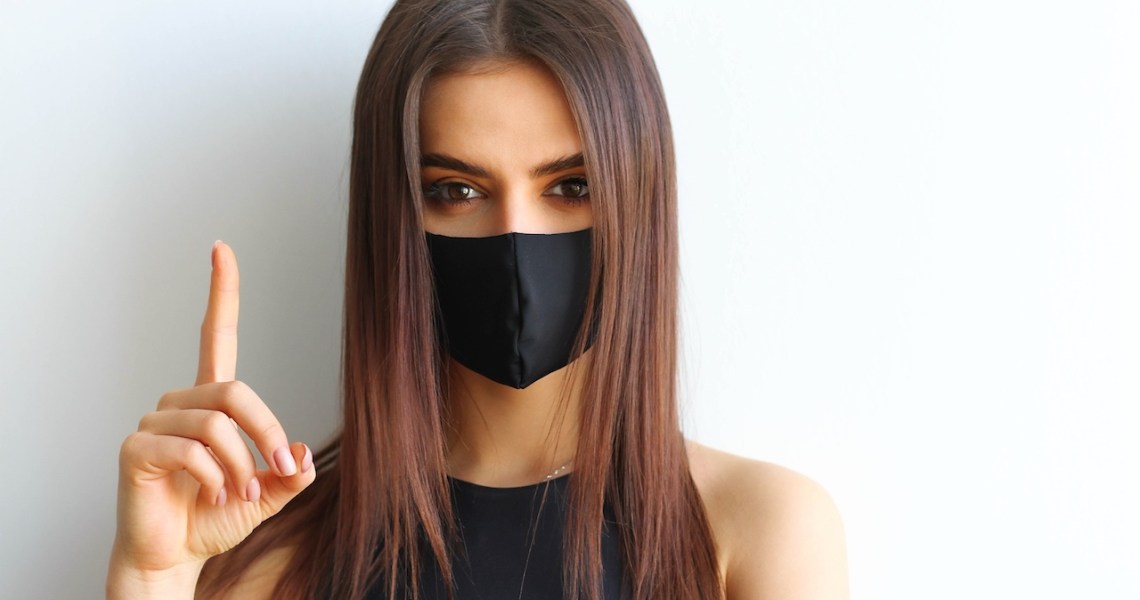The Center for Disease Control (CDC) has announced that vaccinated people throughout the U.S. can go unmasked in certain public settings, and big chains like Macy’s and Target have already lifted mask mandates for vaccinated customers. Still, 66% of people are still uncomfortable going maskless and say they’ll most likely continue donning face masks outside. With policies changing, mesh masks are slowly being embraced as a transitional accessory. Is this the next phase of face-mask fashion?
Sparkly mesh masks, which have their roots in rave fashion, were seen as anti-masks during the pandemic. That includes the one notably worn by Lana Del Rey in October. Deemed inappropriate and ineffective, they’re often made of rhinestone-bedazzled mesh and provide no protection from infectious droplets. Dr. Peter Chin-Hong, who spoke to Billboard last year about Del Rey’s version, said the style is seeing a revival due to the updated guidelines. “Because our new CDC guidance permits more situations for vaccinated folks to not wear masks, wearing one may be seen as a fashion statement,” said Chin-Hong. “If you’re wearing it as a symbol of what we’ve been through, it’s not a bad thing, but it’s not going to protect you.”
From June to July of 2020, online searches for sparkly masks were at a high, coinciding with the rise of anti-maskers. Although the masks enraged the Twitter community last year, positive queries about wearing them are surfacing this year, and searches on where people can buy the accessories post-vax are up. According to Google Trends, searches for ‘rhinestone mesh masks’ rose again May 2021, aligning with people getting vaccinated. On social media, 5.8k Instagram posts are tagged with #rhinestonemasks and there are 84k views of #sparklemasks on Tiktok, showing there is an appeal — most of the corresponding images feature mesh styles.
At the time of this reporting, Etsy listings for ‘‘sparkle masks”, “rhinestone mesh masks” and “mesh masks” totaled 53,089, showing an increase in production and demand. According to Ghazal Javidzad, founder of Los Angeles-based rave fashion brand Rave Wonderland, sales of sparkly mesh masks also spiked at the height of Covid. “I’m not sure if we got a specific spike because these celebrities were wearing them, but in general, there has been an interest in them.”
According to Statista, the face mask market will continue to rise and is expected to be worth $170 million by 2025. This could be an opportunity for brands to dive into a fresh category. Even luxury fashion houses can keep face masks in mind as a consumer entry point to their brand. D. Amores, an epidemiologist and data analyst, also foresees that face masks are here to stay. “I do see a future for face masks,” he said. “People will be more prepared for a future pandemic because of Covid.”
As we transition into a “next normal,” new fashion faux pas and no-mask anxieties have emerged. Vaccinated people online and on Tiktok lament whether to wear a mask. Many are wearing them in order to dodge being wrongfully called out or to make themselves feel comfortable around unmasked people.
According to fashion psychologist and behavioral therapist Jourdan Marie Mills, wearing a mesh mask, like going unmasked, will read as suspicious, to some. “[Wearing] these mesh masks is a personal choice, however [wearers] should be prepared for other people to approach them if out in public,” said Mills. With call-out culture so prominent in our lives, those who are technically able to go unmasked are wondering how they will be perceived if they enjoy the perks of being vaccinated. “With the pandemic, no one knows who has been vaccinated or not.”
Ad position: web_incontent_pos1
With facemask consumption predicted to rise, masks could become commonplace in the West, as they are in the East. “Long before Covid, countries such as Japan and South Korea wore face masks to battle common illnesses such as colds and even air pollution,” said Amores. According to Bloomberg last July, frequent face mask wearers in China, Japan and Hong Kong significantly increased their usage after mask mandates were applied. This surge is reflected in the latest New Woven report, predicting that the face mask market in Asia will reach $2 billion by 2026.




